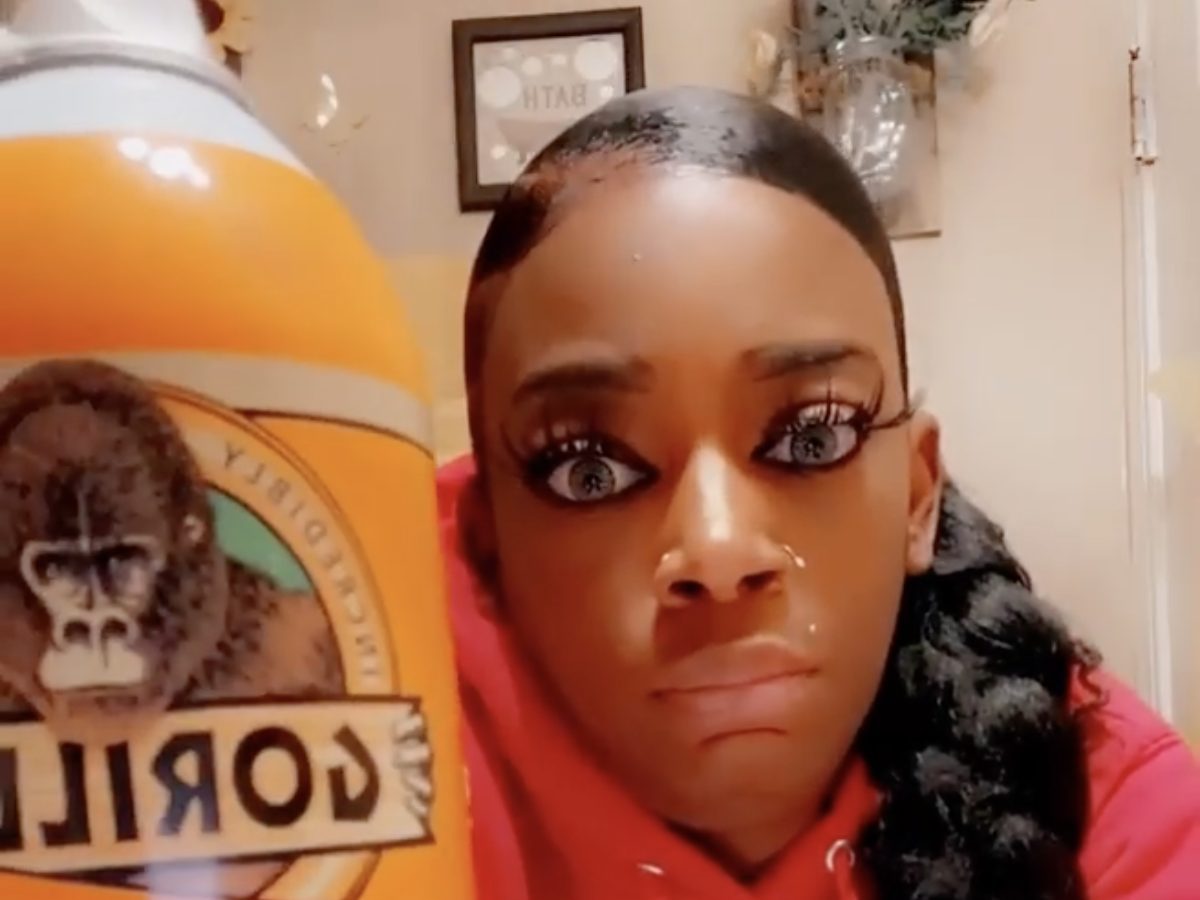“Gorilla Glue girl,” otherwise known as Tessica Brown from Louisiana, has just been released from her hardened hair prison after Michael Obeng, a plastic surgeon from Southern California, performed surgery to remove the adhesive chemicals from her hair. Using his own solvent composed of medical-grade adhesive remover, aloe vera and a tiny amount of acetone, Dr. Obeng was able to dissolve the Gorilla Glue from Brown’s head without burning or permanently maiming her scalp.
The saga started after Brown posted an Instagram video on Feb. 3 detailing her brutal struggle with her hair after using Gorilla Glue adhesive spray as a replacement for Got2B Glue hairspray almost a month prior. Acknowledging that her decision was perhaps “a bad bad idea,” Brown revealed that the hair on her scalp was immobile despite washing it with shampoo 15 times.
Dubbing her the “Gorilla Glue girl,” the internet exploded with opinions that either sympathized with her condition or cracked jokes at her expense (at times both). Many suggested DIY (do-it-yourself) remedies to remove the glue at home, some of which Brown did try, including a coconut and tea tree oil concoction, while others urged her to immediately go to the emergency room in fear that the prolonged exposure to the chemicals in the adhesive would cause brain damage.
While most of the comments toward Brown were initially positive, with only a few berating her for the mistake, public opinion suddenly twisted after TMZ published an article claiming that Gorilla Glue girl was going to sue Gorilla Glue. This was proven to be false quite quickly by Brown. Claiming that she was scamming the public for sympathy and money, many expressed outrage at the mere thought that Brown may have a case against the popular adhesive company.
How are you going to use Gorilla Glue on your hair and then have the audacity to sue them???
— gear 5 (@WhatsaCDRom) February 11, 2021
Brown was also essentially crucified by the public for creating a GoFundMe that would cover her medical expenses after also confirming that she would receive treatment from Dr. Obeng. The GoFundMe raised almost $20,000, which some argued could have gone to many different charities and businesses who desperately needed more cash during the pandemic.
Let’s talk about this video clip what are your thoughts 💭!!!!!
👇👇👇👇👇👇🙏 pic.twitter.com/rOHIgETrdg— richlux713 (@RichLux713) February 13, 2021
With all of the public outrage, Gorilla Glue girl opened up a recurring discourse that has been found on almost all social media platforms in recent years: “Where does the responsibility of a company end and a consumer’s begin?”
Often likening Brown’s condition to the seemingly “frivolous” lawsuit in which a woman sued McDonald’s due to injuries resulting from their hot coffee, critics of Gorilla Glue girl have expressed their support for the major corporation. However, those who cite this lawsuit as frivolous and unnecessary are likely victims of the massive propaganda campaign McDonald’s employed to gain support during and after the case.
In actuality, the details of the case are particularly gory and even disturbing. In 1992, after Stella Liebeck bought a takeout coffee from a McDonald’s drive-thru in Albuquerque and accidentally spilled it on herself, Liebeck suffered third-degree burns on her inner thigh and required skin grafts. As she was wearing sweatpants, the cotton absorbed the liquid and kept it against her skin, causing her to be in immense pain.
For many, it seems obvious that hot coffee should be dealt with carefully, and therefore Liebeck had no real case and McDonald’s was the victim of an exploitative lawsuit.
However, it seems reasonable that user error should be accounted for when selling any kind of product. McDonald’s coffee was not just hot, but it was dangerously hot, enough so that user error (in this case spilling it upon oneself) was not taken into account. The court found that McDonald’s coffee was brewing their coffee and holding it at 180 to 190 degrees Fahrenheit, and if coffee spilled on someone at that temperature, it could cause third-degree burns. If spilling a minuscule amount of coffee on someone could permanently maim them, perhaps one should not be brewing the coffee to be that hot and they should take responsibility for the injuries the coffee causes.
Originally, Liebeck offered to settle the case with McDonald’s for $20,000, which only covered her medical expenses. However, McDonald’s refused to offer a penny more than $800, and Liebeck was forced to take them to court, where a jury decided that she was due two days worth of revenue of McDonald’s coffee sales — $3 million. The original damage award, however, was significantly reduced by a judge, which led McDonald’s and Liebeck to reach a confidential settlement.
This was not the first time that McDonald’s had been in hot water due to its hot coffee. There had already been 700 prior reports of injuries in which third-degree burns were quite common. It was clear that the restaurant had chosen to brew its coffee at this temperature because it would have been cheaper to just settle lawsuits in court rather than lose out on the possible coffee revenue if the coffee was not as hot and thus expired.
Even though the blame is almost entirely upon McDonald’s, people still cite this case as one in which the consumer was trying to pull a cash grab — perhaps because of the massive smear campaign the company pulled in order to hide their culpability, claiming that Liebeck was taking advantage of the failing court system.
Gorilla Glue girl’s hypothetical lawsuit garnered the same kind of attention from the public, with most insisting that she had no case and was just trying to exploit cash from a major corporation. To play devil’s advocate, while it is perhaps true that user error was mostly the consumer’s responsibility in this particular situation, as most adhesives, especially permanent adhesives, have clear warnings to avoid contact with skin, was it not at least partially the company’s responsibility to create a solvent that could account for contact with skin? If such a powerful adhesive can cause someone’s skin such damage, it seems obvious that there should be an available solvent in case children or even pets accidentally use the product.
I do agree that Brown should not sue the adhesive company as she would likely lose in the court of law. However, the massive amount of hate toward her is quite surprising after observing anti-corporate trends that have been prevalent throughout social media in recent weeks.
Only a few weeks ago, the entire internet was rooting for the rise of GameStop and AMC stock to burn major hedge funds and run them into the ground. Throughout the internet, people were celebrating the downfall of millionaires and billionaires as many laypeople who invested felt their pockets increase.
A few days later, people have taken a 180 and are advocating for a major corporation like Gorilla Glue to the point of verbally harassing Brown. While Wall Street and an adhesive company may not be comparable, both exemplify a case of major companies facing off with the individual. One could say that there was too much user error in this case to justify any sort of support, but there were still some, who in keeping with the anti-corporate sentiment, did want Brown to sue, even stating that they wanted the Gorilla Glue company to be held accountable.
Gorilla Glue, hair is NOT skin.
Your product failed to adequately warn, knowing hair glue in fact exists and many Black women use hair glue as hair adhesive & for this, your company is liable.
You should have given her a sponsorship deal.
Instead you will be held accountable https://t.co/DvLzfFVkJI
— 𝐄𝐱𝐚𝐯𝐢𝐞𝐫 𝐏𝐨𝐩𝐞 (@exavierpope) February 8, 2021
However, there were loads of replies to this very comment to prove that this was not a very popular sentiment.
Whether you agree with the mass public or not, it is still interesting to observe the fickleness of social media when assigning blame to either an individual or a corporation. Perhaps, the internet just works on a case-by-case basis, only offering its support to those it deems worthy, and in this situation, Gorilla Glue girl just did not meet the requirements.

















